Morio Nishimura, Bronze SculptureSeptember 13 - October 18, 2008 taguchi fine art, ltd. |
|
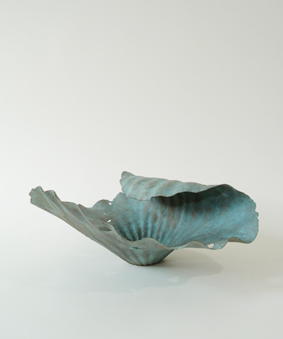
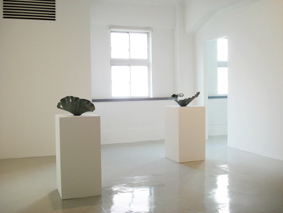
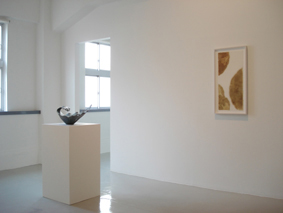
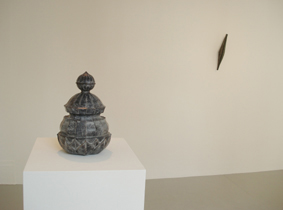
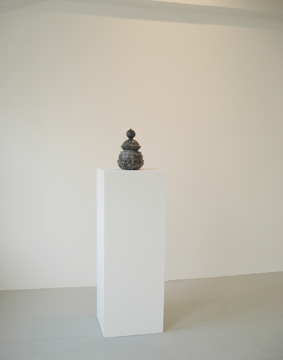
|
Born in Tokyo in 1960, Morio Nishimura now resides in Meerbusch, Germany. After having graduated from Tama Art University in 1985, he moved to Germany as DAAD student in 1991. Got the Meisterschueler from Gueter Ucker at the Art Academy in Dueseldorf in 1995. Under the Japanese government overseas study program for artists, he studied on religion and contemporary art at the department of culture and spiritual history at the art academy in Johannes Gutenberg-University, Mainz from 1998 to 1999 and stayed there as a lecturer for two and half years. In 2001, received the title of "the artist of Kunst-Station Sankt Peter, Koeln 2001-02" . suesser Regen (sweet rain)Nishimura investigates into the relation between human being and the world through taking various religious activities around the world as the motif of his works.The serial work titled "suesser Regen (sweet rain)" is wooden sculptures of which motif is lotus leaves. "Lotus" is very important plant for Buddhism as the symbol of "Rin-ne (emancipation from worldly attachments)" or "Gedatsu (transmigration of the soul)". And it is also the sitting place of Buddha. "Sweet rain" is the rain which Ryu-oh (king of dragon) let fall down to the earth to celebrate the birth of Buddha, giving baby Buddha first bath. Living in Germany, always confronting with his own identity as a foreigner from the far east, Nishimura clearly reaffirmed own interest in Buddhism which is already a part of him. Therefore it is quite understandable that works which deals the idea and objects related to Buddhism are getting more and more important in his recent activities. gelber Sand (yellow sand)Another serial work by Nishimura, "Gelber Sand (Yellow Sand) is sculptures, of which motif is a container of Buddha's ashes and cinerary urn. The sculpture is practically usuful as a container.Nishimura says that container gives him an image of connection of inside with outside or this world with the other world. Before being put the lid, the inside of container stays as a clear space, exposed to light. However, the moment covered with the lid, the space inside is suddenly cut off from this world, unknown another world being created. Thus container can be regarded as a symbol of something which easily connects and separates two different worlds. And inside of cinerary urn is actually the other world in which we physically live after our death, leaving from this world. He titled these works "gelber Sand" - yellow sand flying from desert, which symbolize the spread of Buddhism and culture. Transparent congelation of ideaNishimura always tries to be aware of the energy in everything and every space, which exists regardless of its weight, and the responding relations in-between them. And when producing art works, he carefully proceeds, confirming the inter-penetration between the energy which he puts in or already lurks in the form he creates with his hands, and the energy in the outer space of the form.Followings are his word, "I have no wish to realistically represent or reproduce living lotus leaves. I take it as the motif for my work because it reminds me the idea of Rin-ne or the metaphysical existence as the universe. I am directly giving forms to them. In other words, my work is the transparent congelation of my idea in the form of lotus leaves." Concern with general religious activityNishimura's concern is not only with the Buddhism. So far, on the occasion of the group show at the Ministry of Art and Culture, Port-Luis, Mauritius, "Made in Mauritius" in 1995, he made a Hindu temple with cement and mirror. At the Sankt Stephan Kirche in Mainz, "Kreuzgang" in 1998, made a wooden bed with fur devoted to Christ.For him, creating art works is not the ultimate purpose. Through taking various religious activities around the world as the motif of his works, Nishimura investigates into the relation between human being and the world. Bronze sculpturesIn Japan, this installation is the occasion to exhibit his new works after an interval of three years since exhibitions in 2005, "Today's Artists" at the Museum of Modern Art, Kamakura and "Kalpa" at taguchi fine art. First time to show cast bronze sculptures from the series "suesser Regen" and "gelber Sand"."Suesser Regen" is originally made of wood. His way of making this sculpture is very unique, first drawing a plan, next sawing plywood boards with contour lines according to the plan, then piling those plywood boards and glue them, and getting smooth curve by carving angles. "Gelber Sand" is originally made of glass, with a technique called "pate de verre (glass paste)", which has its origin in ancient Mesopotamia. The technique is, making a mold from original form made of clay, wax or wood and fill it with glass powder and then melt the glass in an oven. "Suesser Regen" cast in bronze has exhibited in Germany, but this occasion is the world premiere for "gelber Sand". With the traditional material bronze, his works securely got their eternity. checklist of the installation 1. SueBer Regen B-12, 2008 bronze, ed. 1/2 20.5 x 39.5 x 32.5 cm 2. SueBer Regen B-13, 2008 bronze, ed. 1/2 22.0 x 58.0 x 36.0 cm 3. Kalpa, 2008 lotus leaves, paper 63.0 x 30.0 cm 4. SueBer Regen WS B-1, 2008 bronze, ed. 1/2 46.0 x 7.5 x 10.0 cm 5. Gelber Sand B-1, 2008 bronze, ed. 1/2 28.0 x 21.0 x 21.0 cm |